|
Brooklands 1909"
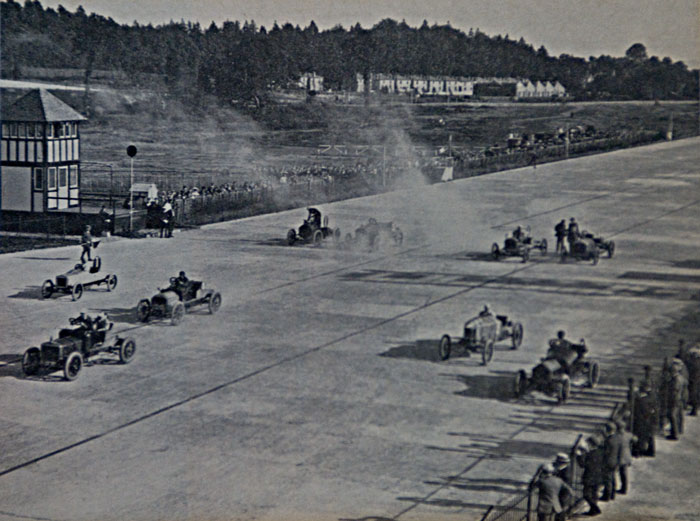
Brooklands, the First Modern Race Track in the World
By Geoff Wheatley 2012
Britain has produced some of the most sensational motor cars in the world, cars that have sold throughout the globe including of course the United States where the MG Marquee has become a household word in company with the Rolls Royce and the Jaguar. Sadly this illustrious history has now virtually disappeared the result of poor management and government bureaucracy. The major Motor manufactures of the world have picked over the bones of the once prosperous British Auto industry and salvaged the Rolls, the Jaguar, the Land Rover and of course the ever famous Mini.
Strange to report Britain was one of the last European countries to have a motor industry. The first recorded motor vehicle to be produced in the United Kingdom was the Arnold Benz, which was a combination of the German Benz 1.5 lire power unit and the Arnold carriage company. About fifteen cars were produced over a two year period, 1896 to 1898, twelve were sold the others went to pay off debts when the company went out of business. At the same time the German Daimler Motor company opened a factory in Britain to produce Daimler vehicles under license. This was successful and about twenty expensive cars were produced each year until the turn of the century. Later Daimler combined with Benz to create the famous Daimler Benz. In 1898 another motor company appeared, this time a totally British venture. The Arrol-Johnston Dog Cart, made in Glasgow , Scotland . In reality this was a compact style of horse carriage with two rows of seats placed back to back and a two cylinder power unit driving a chain to the rear wheels. When compared with the powerful vehicles being produced in Germany , France Italy and America , this was a very poor relative and of course had a limited life span being superceded in 1904 by a more conventional vehicle from the same stable that lasted into the 1920's.
1902 Napier Submitted by
Rick Feibusch, 2012
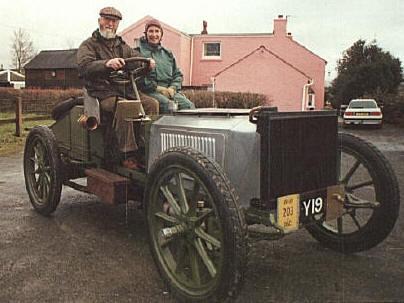
Why was Britain so far behind its neighbors across the English Channel and the USA ? Simple answer the Government of the day who decided that these devices were a danger to public health and limb so they first tried to ban imports which did not succeed, then they imposed a speed limit of four miles an hour on all motor vehicles. This figure was selected by a special House of Commons Committee in 1889 when a few European vehicles continued to be imported into the United Kingdom by the wealthy sporting fraternity. Four miles an hour was the recognized speed limit of a horse drawn wagon so to be fair to all concerned, including the wagon owners, four miles an hour was the order of the day. Almost at the same time the European manufactures were supporting road races with average speeds of thirty and even forty miles per hour, run on city and country roads with money prizes to the winners. Distances like Paris , France to Milan , Italy were the order of the day as early as 1895, yet in Britain the only way you could drive your imported car was with a man in front with a red flag, at four miles an hour. If a British owner wanted to race his vehicle he was forced to travel to Europe where he seldom won anything because the opportunity to practice did not exist at home. Two British names stand out during this period, Charles Jarrott and S.F. Edge who would race abroad without much success but were still determined to have a British vehicle represented. (Note these names as they are important in this review just a few years later.) The situation in Britain was not improved by the 1903 Paris to Madrid race where spectators were killed when two cars drove into the crowds lined along the highway. A few hours later another car missed a bend and went into a group of school children killing most of them. The British media had a heyday with headlines like "No Killer Cars On Our Roads". The government continued to view the motor vehicle as a public danger to be strictly controlled and certainly banned any form of racing on public highways. However, under pressure from special interests groups they did raise the speed limit to twelve miles an hour and to twenty in 1908. (The latter because the King had decided that motoring was a nice way to enjoy an afternoon and in consequence most of Britain 's high society joined him by purchasing a motor car.)
De Dion Bouton Henri Binder Tonneau 1904
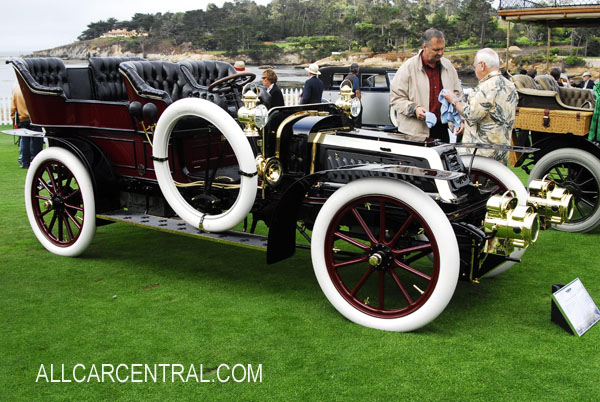
The first recorded long distant car event was in 1904, a run (not a race), from London to Edinburgh staged by the British Auto Club. Charles Jarrott was caught in a police speed trap at 15 miles an hour. He was fined the sum of twenty pounds and warned that any further attempts at reckless driving would land him in prison. Just four years later driving in the Kings Motor Cup Rally Jarrott averaged a speed of thirty miles per hour, took the Kings Cup, and became a national hero. However, he was fined for exceeding the speed limit by a county magistrate who read the report of his success in his local newspaper. Such are the winds of fate!
1904 London to Brighton Vintage Run Submitted by
Rick Feibusch, 2012
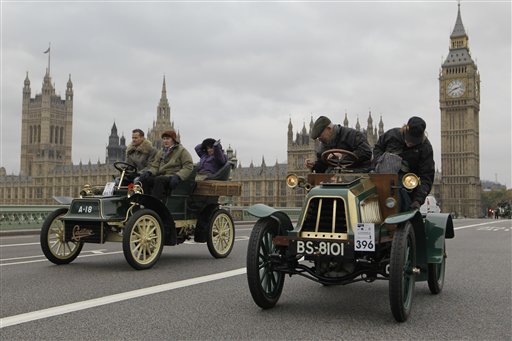
Among the early devotees of the motor car was H.F. Locke King a successful international builder and owner of an English estate near Weybridge in the county of Surrey . A sleepy little village of about 200 inhabitants most of whom were enjoying the rural life of England with no idea of the delights of the motor car or its future impact on their domain. Locke King was extremely well heeled from his many building activities within the British Empire . His great claim to fame was the Mena House Hotel near Cairo , a famous spot to visit on your world tour! In September 1905 he took his 70 H.P Italia motor car across Italy to attend the famous road race at Brescia , Italy . Regretfully, due to mechanical problems they arrived to find the race over and that evening in the inn where they were staying they heard the local Italians praising the driving skills of their countrymen and laughing at the attempts of the two British entrants Mr. Jarrett and Mr. Edge who virtually came last in the race due to mechanical problems. Locke King bit his lip and said nothing but the next day set off to return to Briton and to visit the secretary of the now re-named Royal Automobile Club that boasted the Royal Monarch as its patron. The secretary, Mr. Julian Orde, had given a interview to the London Mail a few weeks earlier saying that the Britain needed a circular track to be built to encourage British motorists to train and become part of the European motor fraternity. Locke King had the land to build such a location and with a little help from the RAC and of course it's Patron, the means to raise the money for such a venture was assured. Orde promised to contact a few people who were now part of the exclusive band of wealthy Motor Enthusiasts and to mention the idea to the King who might be persuaded to give the project the nod of royal approval. In reality no such "nod" came but a wink was certainly given and within a matter of weeks a committee was formed who undertook to fund the project to the tune of one hundred thousand pounds. About three million in today's currency. The committee decided that the track should be flat and not wider than twenty feet with a speed limit of sixty miles an hour. The business design was given to Colonel Holden, the man credited with designing the first motor bicycle. (This claim may be disputed or could mean in the United Kingdom .) Either way he was quite an engineer and saw the need for a more dramatic course to test and try out cars. He pointed out that to achieve any real race environment banking should be included in the design. He went on to say that this banking should be at least twenty to twenty eight feet high. Such an idea had never been tried before and the construction was a challenge to any civil engineer.
1904 Fiat Submitted by
Rick Feibusch, 2012
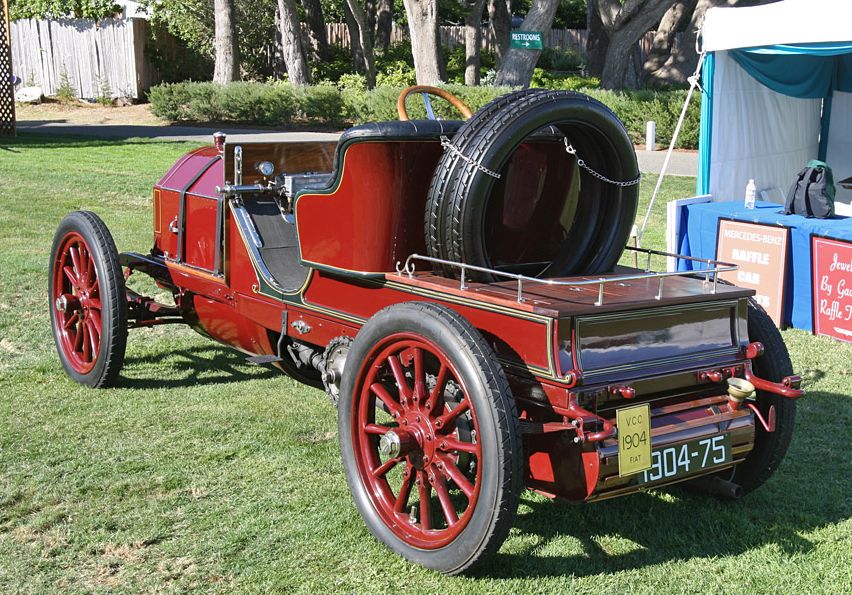
In the late 1890's an American race fan had proposed building such a track but the whole idea was rejected as being both dangerous and expensive. In France a similar proposal had been thrown out for much the same reasons. So in the sleepy village of Weybridge just a few miles from the City of London , history was to be made. But not without conflict and cost. By the spring of 1906 contracts had been signed and work was due to commence on a unique motor track that would be three miles long , oval shaped, with banked curves set at a radii of 1,000 and 1,500 feet. The finishing straight was a full kilometer and the whole structure to be made of reinforced concrete. There would also be grandstands for thirty thousand people and the whole venture to be named after Locke King's successful race horse "Brooklands". Obviously the original estimate of one hundred thousand pounds was now inadequate, the figure expanded by another fifty thousand with an open end just in case the estimates were wrong. Locke King guaranteed this extra expenditure which in reality represented his entire fortune. A brave step for a man who simply liked driving a motor car!
Within a couple of weeks an army of builders and all the other people connected with construction descended on Weybridge. Machines designed to move mountains were brought by new railway lines laid across the green meadows and bluebell woods surrounding the small community. It was without doubt a major invasion of the modern world. Fifteen hundred men and their followers descended on the village and soon founded a colony almost ten times as big as Weybridge!. The first problem was where to house these people as there was no accommodation available in the village. Some slept under trees in the woods, others in the church yard with gravestones as pillows. Makeshift huts of corrugated iron sprung up for the laborers while the artisans sported tents of various design. The village was outraged by this intrusion especially as the sanitation arrangements were, to say the least, primitive! The roadside became the general toilet for the workers and it was even recorded at a village meeting that many private gardens served the same purpose. The only person who was happy about the situation was the owner of the Village pub, the "Hand and Spear" who squeezed over two hundred workers through his twelve by fourteen foot bar every night including Sunday!
1904 Napier
Submitted by
Rick Feibusch, 2009
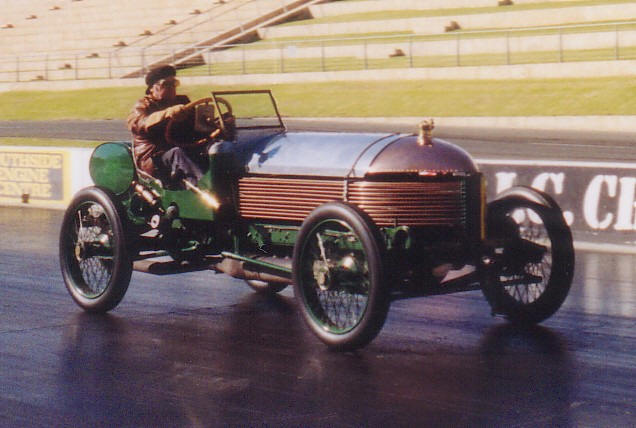
Law and order was another problem. Weybridge did not have a village police station in fact it only had part time cop who now had the task of trying to keep order over fifteen hundred workers. A cry for help went out from the village population that was soon picked up by the national press. One reporter stated that he had visited the village to find drunkenness, vice and even smallpox. Quote; I visited the motor rack and found 18 crude shelters in which 80 or more men and occasionally a few women slept every night. The fortunate ones had a plank but the majority slept on the ground Food was usually uncooked and fresh water a luxury." The local Medical Officer of Health ordered several of the huts to be removed or even burnt down which simply added to the problems.
On top of all that the village claimed that a PUBLIC WALK OF WAY existed on land that the race track occupied. A historical trace was ordered by the local magistrate as the claim exceeded the statute 100 years of common use. It was accepted that there was a common way that had been used by the locals across Locke Kings estate that did touch the proposed race course. However, the claim was that this had existed for over a thousand years and that Benedictine monks had used this right of way when there was a monastery on the land was rejected.
The two local councils became involved with the debate and even threatened legal action against Locke King on the grounds that this was a public free way maintained by their work staff. This was not quite true, in fact nothing had been done to the free way for years and most people did not even know of its existence. In the end Locke King came to an arrangement that a new right of way would be donated on his estate and maintained by his staff. That was the end of the issue. Before the dust had settled over the free way one of the workmen found a hoard of Roman coins which by law belonged to the crown.
The finder and the owner of the land where the coins were found could claim "Treasure Rights", but for reasons that are not clear neither the finder nor Locke King did this.
However, this did prompt a claim by the village that there could be a Roam Villa located on the estate and that all work should stop until excavations to find the villa were completed. Again this issue went to court and was deferred for expert advice. None was ever obtained and the notice of work stoppage was lifted, in fact it never was applied in any real sense by the local court and construction continued throughout the proceedings. The fact that no one contested a share of the Roman treasure which went to the British Treasury may well have helped to quash the legal claim re a Roman villa!
By June the workmen had completed the heavy construction. When they arrived they had found a peaceful district covered with wild flowers and country woods. When they departed they left behind the first banked motor track in the world, with a circuit of three miles and a width of over a hundred feet. To achieve this they had laid seven miles of new railway track, and used a total of twenty five thousand sleepers. This was removed when the crews left and no one seems to know where either the track or the fifteen hundred workers relocated. They just seemed to fade away like old soldiers!
Only one problem remained, the soil on which the track was built was mostly sand or light earth, this condition being enhanced by the removal of the tress. It was liable to subside and / or leave depressions on the surface of the track. On top of that the river "Wey", ran through the center of the course and then turned back on its self and crossed the finishing straight. To get the track over this was an engineering miracle. The French company "Hennebique" was, at that time, the worlds leading producers of ferroconcrete. They were also superb engineers and created a structure of concrete piles sunk into the river which in turn supported a seven inch thickness of concrete which in turn supported the actual track that was reinforced with steel and iron. From the outside looking at the track from the banks of the river the structure looked a little frail but in reality it was as good as a solid base of bricks and mortar, perhaps even better. (Many years later during the second world war when it was decided to break up the track in case the German bombers used it as a guide to London, this section was the most difficult to demolish!)
The next confrontation took place between Colonel Holden and the committee who wanted to know how fast a car could or should travel on the new track. Holden said he did not know. Sixty was the mean figure for the center line but at the top of the banked track it could be one hundred and twenty! Of course all of this was quite wrong as the real performance depends on the ability of the driver, the way the tires would stick to the floor, the difference between the various radius of each curve etc.
The next task was to sell the idea of Brooklands to the public and it was decided that the best approach was to promote the whole idea of a day at the motor races as a new English sport like going to the horse track with the family, a picnic basket and folding chairs. Horse racing was at its peak at this time, an average race card at an average track would get as many as fifty thousand people some with their own box, others in the Club House and the vast majority on the grounds of the course with deck chairs, hampers, crates of beer and all the other necessities for a good days outing. It was also indicated that motor cars would be raced on exactly the same principles as horses, with all the same rules and regulations.
The track committee was packed with famous names from the turf, as it was recognized by the Brooklands owners that such names would be like magnets to the crowds. The President was Lord Lonsdale who was known throughout Europe as the patron of the noble sport of Boxing. He also had a fine stable of horses that had won many races both sides of the Atlantic . The "Board Gentlemen of the Jockey Club", were also included which meant that Huge Owen the national starter was on the committee. This proved to be a very wise move, more on that later! As expected the committee borrowed the vernacular of the Turf and the procedure. All cars were to be weighed, drivers to wear owners colors, winners to receive silver plates and large sums of prize money. The only thing missing was a recorded history of the pedigree of each car and I am sure this would have been published if it were available! People began to take interest, newspapers started to compare Weybridge with Newmarket the home of British horse racing. All this before the track was officially open or the real costs of building published. The final bill came to just over one hundred and fifty thousand pounds which meant that Locke King was on the line for the balance of fifty thousand. No matter, the owners committee were convinced that this would be paid off in a matter of months from the record crowds that they expected to support the track. The bank agreed to hold the overdraft for a further twelve months at a modest interest rate and the owners agreed to pay the interest until the debt was cleared.
Brooklands 1908 and De Dietrich driver Charles Jarrott
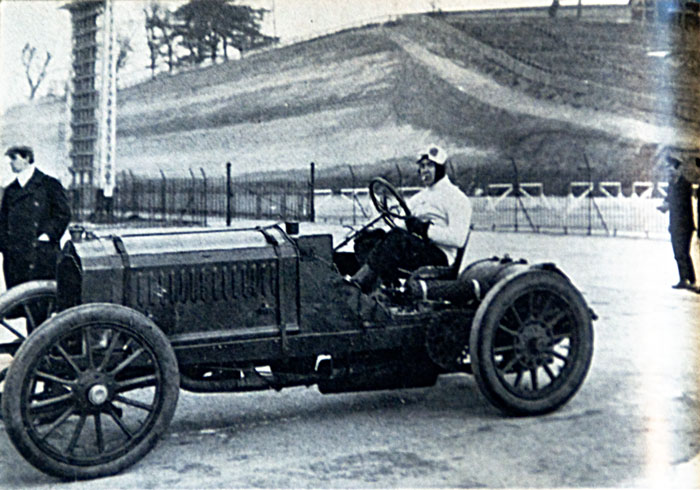
The course was officially opened for business on July 6 th 1907 . A series of open races were scheduled, with no structured race card. The big boys with their eight cylinder vehicles and the other guys with more modest power units all raced together. The fact that the cars were weighed had no influence on the line up. Jockey colors were worn by the drivers which was the only way to identify a car. A crowd of about four thousand people arrived and paid two shillings and six pence to get in. Twice the fee to attend a day at the horse track. The catering arrangements failed for a variety of reasons including the fact that the entrance to Brooklands was so narrow that it could not accommodate cars, bikes and coaches at the same time. The food was late, the drink even later which was a major disaster as the Brits associated a race meeting with a fair consumption of ale. No one had considered how small the cars would look two miles away from the viewing sections, further more on one could tell "who was who", as the drivers colors were simply lost in a sea of dust. The big cars won every time so there was no anticipation of drama or any incentive to bet. In short not a successful first day with the press adding their views of a disappointing event not to be repeated. The Owners committee scheduled a special meeting to try and sort out the problems and Locke King started to wonder if he had done the right thing in creating this modern motor track. Some thing was needed to breathe new life into the still born Brooklands. It came through our old friend Mr. S.F. Edge who had strove to win a few races in Europe for his country a few years earlier.
He approached Locke King and asked if the owners would let him rent the track for twenty four hours to attempt to beat a world record. King was more than willing to give him the track for as long as he wished knowing that if he was successful it would help restore the attraction of Brooklands... So the first international challenge recorded at Brooklands was just two weeks after the course was officially opened, and it came at a time when the future looked rather uncertain. Edge wanted the course in order to challenge the American record of eight hundred miles in twenty four hours. He proclaimed that his vehicle a "Napier Speed King", (He chose the term Speed King), would achieve the impossible by driving fourteen hundred and forty four miles in twenty four hours at an average speed of sixty M.P.H.
Needless to say this caused quite a stir in the press despite the fact that just two weeks earlier they had virtually written off Brooklands and British Motor Racing. The general public even those who did not like Motor Cars or their drivers, saw this first Brooklands international adventure as a new world crown for Britain. The King sent a telegram to Edge saying that the country was with him every mile of the drive. A motion was passed in Parliament supporting his endeavors and the House of Lords simply praised his endeavors and invited him to lunch! Never one to seek the shadows Edge gave daily news briefs in which he prophesied what the drive would be like. Quote; "The solitude of this great race track and the howling gale of sixty miles an hour will test the ability of both the driver and his car. I have no doubt that both will come through with flying colors." One hour before noon on July 28th 1907 the Napier was loaded with grapes, bananas and ginger beer, a doctor made a final examination of the driver, perhaps his last, and at one minute past mid day the car roared into action. Hour by hour the press reported his progress and even described the various stops he made to drink cold tea and/or have a tire changed. The first problem Edge encountered was dust, lots of it from the new concrete surface of the track. The car was an open version of the Napier and the only protection for the driver was a small windscreen and a pair of motoring goggles. In the daylight it was possible to see the center of the track through the dust but at night it was impossible. During an early evening stop a mechanic suggested that a row of oil lamps be placed along the center line of the track and that flares be set at various locations to guide the driver. Three miles of oil lamps is a fair number but within an hour they had been located through the help of the press the police and the locals who by now had become attached to the Brooklands venture. As night descended Edge positioned his car in line with the lights and pressed on. The ceaseless roar of the engine, the never ending dust, the endurance, and self determination kept him going as dawn broke on the summer morning of July 29 th 1907. It was estimated that over fifteen hundred people camped out all night to cheer Edge on his way and to be there when he finished.
Midday was the point where he and they would know if the record had been broken. Twenty four hours of driving, well this had been done by the Yanks, but could he push the average speed to sixty and travel fourteen hundred miles in such a time span? As the Napier came to a stop at two minutes past noon a new world record had been set, One thousand five hundred and forty one miles in twenty four hours at an average speed of sixty four miles an hour. Just to add the final cherry on the trophy Edge had done this alone, the American record was with two drivers. The national media went quite mad, front page news, with Edge the "Man of the Moment". The crowds had swelled to over three thousand many of them people who had apposed the building of Brooklands. The local pub once again did a roaring trade and even suggested the name be changed to the "Edgeworth Arms". It is not recorded if he ever went to lunch at the House of Lords but the King certainly granted him an audience and a visit to the Royal Box at Ascot the next year. This achievement put new life into Brooklands with all the national and European media covering the story. The price was reduced to one shilling, the same as the horse track, and the owner committee asked for further recommendations which were easily given by people who were not connected to the Turf, and one who certainly was!
Mr. A.V. Ebblewhite was an active member of the Jockey Club and had been invited to join the management team by Lord Lonsdale. To justify his position he was given the title of "Official Circuit Counter". In reality this meant that he supervised the weighing of the cars and insured that drivers wore the correct colors. When he proposed that the cars should be handicapped by size and that they should race in such categories his recommendations were rejected. However, as he was the official circuit counter he could impose such regulations, and he did! He also pointed out that the drivers colors were to say the least unsatisfactory, cars should have numbers like horses so that people could see who was in front and who was behind even at a distance of one or two miles. The races should be staged with a minimum of wasted time. It was the custom to have at least half an hour between any horse race, often this was longer, but with the motor car there was no need for such delays the cars were ready to go almost as soon as a one race ended. People lost interest if they had to stand around for up to forty five minutes. Needless to say the Owners Committee were horrified and wanted to remove him from office before the next Brooklands Race Day dawned. Locke King who had the majority vote and of course the most to lose if the who thing fell apart, over ruled the committee and allowed Ebblewhite to try out his ideas. The event was an outstanding success. The first race attracted no less that seventeen cars all handicapped and numbered. The race became a battle between two cars much to the delight of the crowd and the press. This pattern continued throughout the day with wagers being placed, cheering crowds and the sound of money in the cash registers, a welcome sound to Locke King and his wife who had put a substantial amount of her own fortune into Brooklands. One other achievement by Ebblewhite was to get rid of the starting gate, a device that was fine for horses but was a danger for motor cars roaring out of a ten foot slot with inches to spare. He proposed that a flag should be used but no one wanted to be the official starter for fear of being run over. In the end he took on the task and was a favorite figure at all future races dressed in a check sporting outfit and a large straw sun hat. When he retired no less that fifty eight people applied for the job including two women, however Brooklands was not quite ready for that development, until the roaring twenties, when there was a regular ladies race at every meeting. In 1910 the King graced Brooklands with an official visit and a new Club House was built to accommodate his presence, this still stands today. Motor racing was now respectable and Britain was busy winning prizes all over the world thanks to Brooklands.
It is also interesting to note that by 1910 the Motor car had become a firm fixture on British roads with such people as Morris and Austin producing cars to such an extent that the London Times, a very conservative publication printed this Editorial "Many motorists cause themselves a large amount of trouble and expense by being rude to policemen. Whatever may be said about the British police force there is no doubt that that it is the most courteous in the world. Policemen however are only human and when motorists abuse them it is only natural that they should become annoyed and that they would exercise their powers to the fullest extent. Certain readers have been known to attempt to bribe our police force when faced with such action. This is a most dangerous procedure!") Wise words that should be heeded today!
©Geoff Wheatley, October 2008
PART 2
After six long years of litigation, and debt Brooklands Race Track had become established as a major motor center, both in England and Europe . Drivers also came to test their skills on this new banked race track from North America , South America and the East. In 1910 the first Japanese driver complete with his Japanese car raced at Brook lands and achieved fourth place in a three hour battle between a Benz and a Napier out of a field of twelve. Drivers from as far away as Australia also competed mostly driving European vehicles as their own home production was still in its infancy. By 1911 most of the outstanding debts had been paid and the Brook lands complex was being run at a profit, the creditors were even ready to put a few more bucks on the table to rebuild the Club House and to make some necessary modifications to the track including extending the length of the finishing section that had become something of a problem as speeds increased but braking ability remained much the same as the day the track opened. Locke King, who had put his personal fortune on the line to create Brook lands and had given the land to the Brooklands Trust, must have breathed a sigh of relief in the fall of 1912 when the last debt had been cleared. Much the same could be said of his wife who had invested part of her own fortune into the venture to support her husbands dream.
In addition to motor racing another attraction had appeared at Brooklands, almost by accident. In order to attract the weekend crowds private owners of aircraft were invited to use the open grass areas at Brooklands, to land and take off in their new flying machines. In certain cases they were offered accommodation to store their aircraft and work on the essential maintenance each time they flew. This accommodation was highly subsidized in order to attract the flyers and their engineers. In reality this accommodation was little more than a collection of wooden sheds with no facilities. Water had to be carried and other basic requirements of life took place behind your neighbors shed when he was not looking! Despite the image of wealth projected by owning an aircraft it soon became obvious that some of these flyers owned little more than their airplane and in consequence were soon fully entrenched in their Brooklands shed complete with a camp bed, oil stove and a tin box for personal gear. Each shed measured about 15 by 24 feet. The average aircraft required about 80% of this accommodation so when you add the workbench, a few tools, a large can of fuel, and some spare fabric, its not to difficult to see that space was a prime consideration therefore the size of the camp bed was critical. The Clerk of the Course turned a blind eye to such use, he wanted the flyers to be there every weekend to fill in the blank periods when cars were being made ready for the track and/or races were being arranged. However, not all the flyers were living on bread and beer, the majority were part of the well heeled class who could spend a few hundred dollars on special design aircraft built to their specifications. By 1912 Sunday flying was fully integrated as a regular feature and there were even days when no cars raced around the track, only string bag flying machines filling the Brook lands sky and doing daring feats like looping the loop or skimming over the trees with a few feet between then and the concrete track. Such famous names as "Sopwith" who not only flew but made aircraft at Brook lands to order, usually for one of the wealthy aviators already mentioned. In addition he also ran a flying school which was quite popular with his customers. Order a plane; take a few lessons while it's being built and then off you go into the pale blue yonder, or what ever! The famous World War One fighter plane the Sopwith Camel saw its first flight at Brooklands in the summer of 1915 thanks to Mr. Sopwith who became quite wealthy as time progressed but lost everything in the 1929 crash and died in much the same financial condition as when he started in two sheds at Brooklands. By 1914 the sheds had developed into small hangers that could hold two or even three aircraft which in turn demanded a few more bucks in rent, this helped keep the Brook lands balance sheet in the black. The history of Brooklands aeronautical achievement during this period was truly magnificent. The first flying boat was designed and built there. Now add the first torpedo-carrying aircraft built for the British navy. It sank a floating target in 1913 much to the amazement of the "Admirals of the Fleet" who saw the airplane as a rich mans toy. To top this three additional navy planes sank a German ship in 1915 off the coast of England which gave birth to the Fleet Air Arm a few years later. The first amour plated fighter, the Salamander, was developed at Brook lands utilizing the metal techniques used for building race cars. Harry Hawker, the founder of the Hawker Aircraft Company which produced the World War Two, Battle of Britain fighter the Hawker Hurricane was a mechanic at Brook lands who rented a shed later to be enlarged into a production hanger which produced hand crafted Hawker aircraft. Mr. A.V. Roe with twenty dollars capital opened his production shed and like Hawker went on to form the famous AVRO Aircraft Company.
Roe's dedication to flying is best illustrated by an incident in 1909 when the famous Wright Brothers flying machine was on display at Le Manns , France as part of a European tour to raise money for future aircraft development. Roe had no money to spare, could not afford to lose working time on the aircraft that he was building for a client, the British Government. Only the second such order at that time and the first British built aircraft purchased by the War Department. The first order placed a few months earlier caused quite a stir in the national press when it was revealed that a French firm had been given the first military contract ever issued by the government for a flying machine! Roe decided that the only way he could see the Wright machine was to bicycle from Brook lands to Southampton on the English coast on a Friday evening after work, a distance of about 45 miles on mainly dirt roads, then board the cross channel steamer ferry to St Malo over night and cycle another 100 miles to Le Manns. He was allowed to inspect the aircraft at no charge on the Saturday afternoon then turned around and repeated his journey back to Brook lands ready for work on Monday morning. Could dedication go further than this?
With the exception of France most governments were not interested in supporting or assisting in the design and production of aircraft. In America the home of worlds first mechanical flight, the flying machine was seen as little more than a five day wonder, any suggestion that such machines could be used for commercial transport or as a part of the armed services was laughed out of court. In Britain the "Magnificent Men in Their Flying Machines" were viewed as rich playboys who kept a bunch of amateurs busy designing and building these toys to amuse the public at special events like Brook lands. Even the prize money offered by national newspapers for the fastest time to Paris or Dublin was seen as a promotional tool rather than an investment in the future of aviation. Only the French could see the potential both for commerce and as a tool to assist their armed forces. In consequence most of the new aircraft designs and production factories sprung up in France , soon to be followed by Germany with their engine powered
Zeppelins. As Europe moved towards war Britiain and her Empire still regarded the Navy as the most powerful arm of the war services and continued to build bigger battleships that were to become the white elephants of conflict. To be fair the navy did order a few airplanes which in turn assisted in the design and development of the Brook lands seaplane built by Saunders Aircraft another one man operation. In the post 1918 war years Saunders Flying Boats flew the world in company with their American cousins but that's another story for another day!
It was almost two years into the First World War before the Royal Flying Corp, still part of the army, made its mark on the battlefields of Europe . The Sopwith aircraft were now one of the main air fighters on the Western Front and by 1916 twin engine planes were being built and used as bombers including the now famous Vickers-Vimey, the first aircraft to cross the Atlantic in 1919 leaving Newfoundland and landing in a bog in Ireland sixteen hundred miles later. The two pilots Alcock and Brown braved a storm, ice and very limited navigation equipment located in open cockpits, managed to survive and succeed. Somewhere over the Atlantic they had to take turns to crawl out onto the wings to chip off the ice.
This aircraft had been fitted at Brooklands towards the end of the war with the then new Rolls Royce Aero engines. One of the major hazards for flyers at Brooklands was the sewage farm at the end of the south runway. If they overshot on landing they would usually end up in this location. If they failed to get enough lift on take off the same thing could apply. On top of that from time to time the spectators on a warm summer's day were fully aware of this facility which did not enhance the joy of an open air picnic! With money in the bank plans were made to modernize this unit, put in water sprinklers and cover the holding tanks rather than have an open cesspit designed many years before to cope with the growing population of south London. Work was due to start in the fall of
1914 but world events put this improvement on hold for another ten years. On a bright sunny day in August 1914 a crown prince was shot in some far off town in Serbia and within a week Europe was at war, a war that would last four long years and claim the youth of a generation. No one is quite sure how many people died between 1914 and 1918 but a conservative estimate is between 100 to 120 million, the largest slaughter in the recorded history of war fare. Within hours of the outbreak Locke King had offered Brook lands for service to his country, an offer accepted immediately by the government. Brook lands was one of only four flying fields throughout Britain and the only one with production hangers and people who could teach other people to fly.
At the same time most of the young and not so young staff who were concerned with Brooklands volunteered for war duty in company with three million others who saw the war as a new adventure not to be missed. The "War to End Wars" was about to commence and no one wanted to miss the fun!
Throughout the duration of the war Brooklands was a training ground for engine development, a production plant for aircraft, a training school for pilots and a testing ground for tanks and other vehicles. The place mushroomed as more and more space was needed for war production.
The track started to break-up especially where the base was little more than sand and cement. The sheds were pulled down and new large aircraft hangers were constructed. The almost new clubhouse became the center of all management activity and the original members grounds was turned into a tent town for training flyers and tank drivers. The latter was equally as interesting as the former; the mobile tank was the wonder weapon of the day, a mobile gun that could travel twenty miles an hour over the most difficult conditions. Where better to test such a toy than the banked curves of Brook lands. Had Locke King not offered Brook lands to the nation for free he could have made a fortune out of the location renting it out to the war department for some inflated sum of money, but this was not the nature of the man. His country came first and in consequence he lost everything that had been built up over the previous years. At the end of the war the track was in a pitiful condition, the river had been allowed to resume its original course straight through the center of the complex, flooding a third of the grounds. The original buildings were in a sad state of repair and the club house, built to entertain a King, was not fit for the royal horses!
Four years of war had reduced Brooklands to a shadow of its former glory. Britain had won the war but the process had broken the nation's bank and money was in short supply. Four million men and women were looking for a peace time job, an election was on the political cards and Brook land's need for government investment was way down on the bottom of the spending list. For the first time in its short history the Brook lands Trust decided to go public and encouraged the media to take up their case for government funds to repair the damage caused by the war.
The national papers smelling a good story made the issue a front page item. Two of the Press Barons even went as far as to start a "Save Brook lands Appeal" and kicked off the project with a ten thousand dollars donation. The public responded in two ways, first to send in their own contributions but more importantly contacted their Members of Parliament demanding that the government pay for the damage and/or supply the skilled labor to complete the restoration. Within three months money was found and the Royal Corp of Engineers were directed to get down to Book lands and sort out the problems. By the summer of 1919 Brook lands was once again open for business but this time with strong competition from other British and European tracks that had seen the potential for motor racing on professional race tracks rather than the open road. Mrs. Locke King once again dug deep into her family fortune and supplied funds for various new innovations. The Test Hill that had been established just prior to the war was extended. And Lindsay Lord, now a full colonel (Retired), returned as Clerk of the Course. He came back with a rather novel idea for the day, a special race card for small race cars up to 1800 cc engine power, with four cylinders or less. This caused quite a stir amongst the racing fraternity. Should the size be a simple 1.5 liter engine? Should three wheelers be allowed on the track? Why was there control on the numbers of cylinders? In the end a formula was adopted that allowed three wheelers to compete but engine size was set at a maximum of 1,100 cc. All other light cars were to be within the 1.5 liter range, but even this had its problems as we will see in due course. Money was extremely tight and most of the people involved with the day to day Brook lands operation worked for love and enough money for their daily bread.
Mercedes 1921
Chitty Bang Bang II
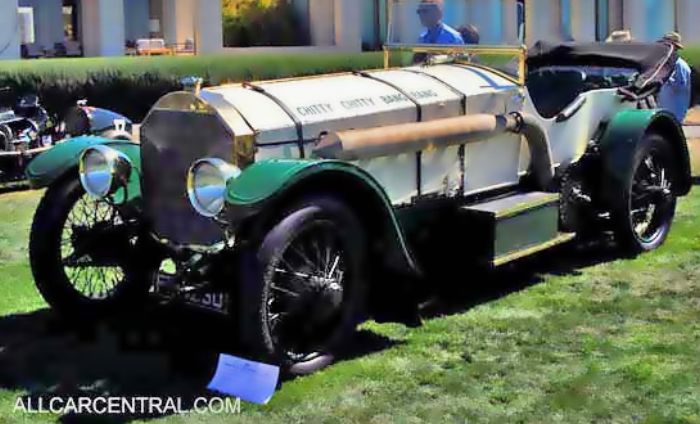
Lindsey Lord was no exception to this situation neither was his assistant who also acted as time keeper come general fill in for any other administration task that required attention. Records only refer to this individual as "Taffy" obviously a Welshman by origin. One of his many jobs was to ensure that competitors did not jump the track. (A banned driving technique where the driver would take his car to the top of the track rim in order to overtake. This had one serious defect, if you moved the steering wheel an inch too far you and your car could easily take off into space with devastating results for all concerned. In fact this had happened in the early days hence the ban on such creative driving.) Taffy had to find a location where he could see the top rim on the Bridge bend and at the same time allow himself some degree of safety. A small wooden hut was erected with a panic hole in the floor just in case. One sunny afternoon during a ten lap race the famous "Chitty Bang Bang" a 23,000 cc powered machine. (that's right a 23 liter engine) driven by Count Zborowski lost adhesion to the track at round 100 mph and headed straight for Taffy and his wooden hut. By some grace of God and a nimble pair of legs, Taffy managed to squeeze into the panic hole a split second before the car demolished his wooden abode.
Damage. One shed and three fingers on Taffy's left hand.
A few years later located in the safety of the brick starting box Taffy sustained a broken leg when a motorcycle managed to leave the starting gate hit a bump and then proceed straight through the viewing window. Records also report that despite these mishaps Taffy died in his own bed from natural causes. One of the sad results of the war was the decline of flying activity at Brooklands. New airdromes had sprung up during the war built by the Air Force and in consequence better suited for the high tech planes of the day. A new commercial airport had been built at Hendon in north London and another in Croydon just a few miles from Brook lands. These were commercial operations that also attracted the new breed of flying club people who were able to purchase war time aircraft at almost give away prices as the government ran down its stock of service aircraft. At one stage you could buy a used war time trainer aircraft for the same price as a small new car. The production hangers built during the war at Brook lands were still intact but the demand for such facilities was to say the least, slim. Vickers Aviation, who had the distinction of being the largest aircraft manufacturer during the war, rented a couple of these hangers and used them to store used and unused war time machines that they sold off at regular auctions. Such was the mood of the day, the War to End All Wars was over, so who needed these machines. The same thing happened throughout the western world including the USA .
A small group of flyers decided that a Brooklands Aero Club should be formed utilizing one of the empty hangers.
A decent plane could be purchased for about $400 and the government would loan you $350 over five years if you could scrape up the deposit. To make the deal even more attractive Brooklands rented the hanger to the Aero Club for a pound a month, about four dollars at the then current rate of exchange. A Col G Henderson, a war time flyer, was the driving force behind the idea of a flying club. He had purchased a couple of old 80 hp Avero's, the plane used by the RFC to train pilots during the war and of course built by our friend Mr. AV Roe at Brooklands. In due course the Brooklands Aviation School came into being later to be renamed the Brook lands School of Flying . At the end of the first year the club was solvent and the flying school showed a profit of around $104. This was enough to convince the bank that there was a future in such ventures.
At this time very few of the rented hangers sported a company or individuals name, most still had their war time identification such as "Flight Four" or "Supply Dept". The reason was simple; when you owe money to just about everyone it's not wise to advertise your location!
Regretfully Mr. and Mrs. Locke King could not use this tactic; their personal fortune was being mortgaged away every day in an attempt to bring Brooklands back to life as a racing center of the world.
Thomas High Speed Special
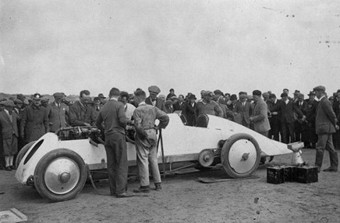
Between 1920 and 1925 the situation began to turn around, the track was professionally restored, the Aero Club and flying school attracted bigger crowds each year and a new breed of drivers emerged as a direct result of the policy of allowing small cars to compete. The Junior Car Club which comprised of several national car clubs who had started to hold their own light car races on hired tracks all over the country, held their first major event at Brook lands, the 200 mile endurance race utilizing standard vehicles tuned and refined by their owners. A couple of years later the Junior Club decided to hold a "Double 12" event which was a weekend race where the competitors ran their cars from 8 am to 8 pm on the two consecutive days. The original idea was to hold a 24 hour race but nocturnal racing was forbidden at Brook lands due to the various legal battles with the neighbors over the years. Each machine that completed the first day's run was locked up for the night under strict security and wheeled out onto the track the next day for another 12 hours of competition. In all the years that this event was staged there was never a recorded incident where a driver attempted to break the rules and work on his car overnight.
The term Junior was in no way any evaluation of the drivers it was simply the term used for the 1.5 liter events against the five, ten, or even twenty five liter power units in other race cars. The record for the highest power train must go to the Thomas High Speed Special at 27,800 cc that set a world lap record in 1926 of 135.77 mph.
Remember these cars had rod brakes direct steering and very little in the way of suspension. On top of that they could weigh up to nine tons resting on four inch tires. Another attraction was the introduction of motor cycle racing in 1921. The first major event that year was the 500 mile inter cycle race. This annual test of skill and will power continued until the track was once again forced to close in 1939 due to the Second World War. By the mid 20's sidecars were added to the race card and this again proved to be a popular event for the spectators.
Morris Cowley 1925
Submitted by
Rick Feibusch, 2012
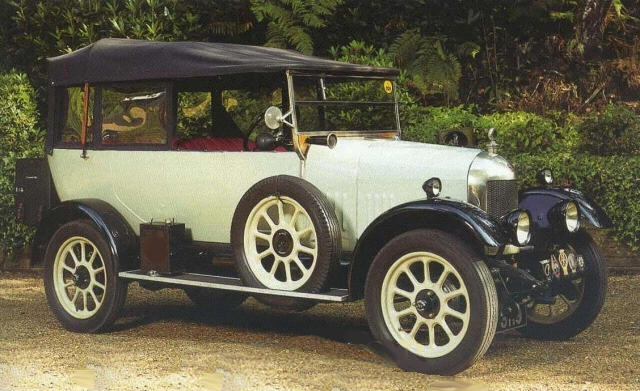
To give some idea of what private owners could do with a mass production vehicle, in 1924 Mr. A.E. Keen took his Morris Cowley family car with a 1200 cc side valve engine, guaranteed by Morris Motors to have a top speed of fifty miles an hour after being "Run In". and turned it into a competition car that achieved 92 M.P.H. during an inter club speed event. He then went on to obtain 86 mph in the flying mile. In 1931 a 750 cc MG midget broke the 100 mph barrier after three attempts. The fist two resulted in 98.51 and 97.99 mph. A wad of glass putty was obtained and every protruding nut and bolt on the body was covered with the putty to reduce wind drag. The end result 101.03 mph. By 1937 speeds in excess of 120 mph were recorded at Brook lands by the Junior Boys, and in 1937 another 750 cc MG recorded 122.4 mph. In 1932 Royalty once again graced Brook lands when the Duke and Duchess of York attended a full race day. No one knew that in a matter of four short years Prince George would become the king and his brother would be virtually banished in company with his American wife from the shores of Britain . King George like his grandfather was a fan of motor sport; he also liked football and was a regular spectator at various soccer matches during his reign. He was regarded by many as the Peoples Monarch simply because he seemed to share and enjoy their pleasures.
By the 1930's Brook lands was once again a success, a ladie's Club addition was built to accommodate the women drivers who were setting new records and achieving endurance results undreamed of just a few years before.
There is a reported story that King George requested that the Royal Train slow down as it passed Brooklands in May 1939 in order that he could see the start of the International Trophy Race. There is a photo of the crowds waving to the train from the Brook lands viewing stands and would you believe it was just prior to the starting flag. Such was the attraction of this incredible race track that both kings and their subjects were captured by the thrill of speed and achievement. In 1939 Europe once again went to war and Brooklands was once again conscripted as a production base for both aircraft and vehicles. Because the race track was so close to London and could easily be seen from the air, sections were broken up and trees planted to try and camouflage the location. In retrospect this was not necessary as the German bombers simply had to follow the river Thames and they were in the center of the nation's capital without any need to locate Brooklands, and its facilities. The track could have been spared but such is the fate of the Gods that the first banked race track in the world should be yet another victim of stupid government policy. Today there is an attempt to recapture the past and sections of the track have been restored in company with the original club house, and speed ramp.
If you are in London take the train to Brooklands and re visit the glory of the past, it's a short ride from any London hotel and well worth the visit. If you stand on the bridge adjacent to the "Members Banking", close your eyes and listen. You will hear the roar of motor engines and the crowd. If you are really a true fan and can concentrate enough, you may even get a whiff of burnt Castrol!
©Geoff Wheatley . October 2012
Reported June 2015
The UK GOVERNMENT has given a major grant for the restoration of the world famous BROOKLANDS RACE TRACK.
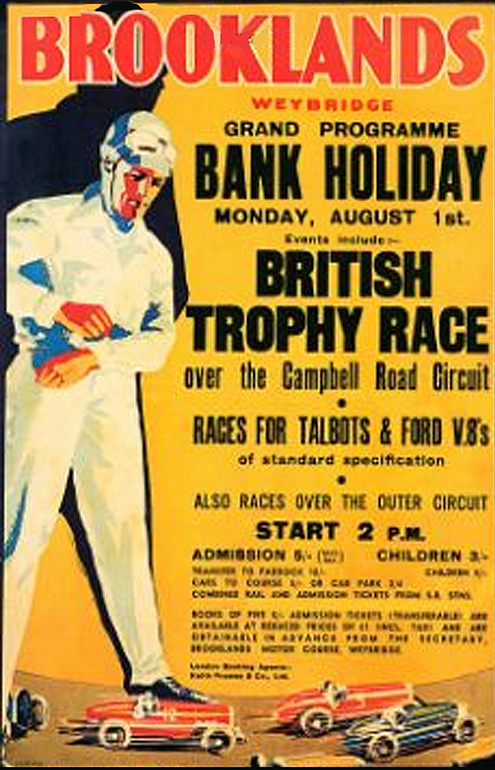
Brooklands Poster
Submitted by
Rick Feibusch, 2012
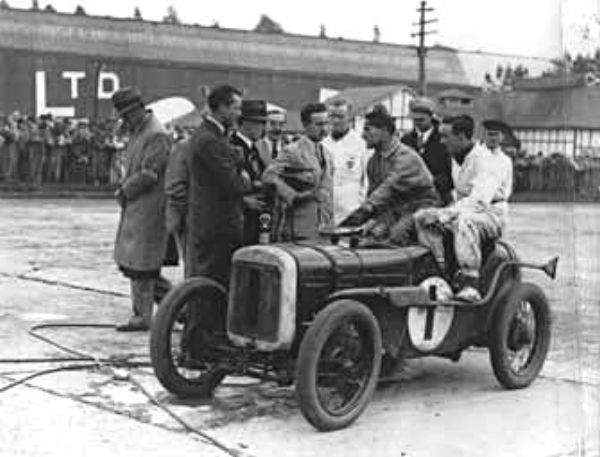
Austin Sevens
Submitted by
Rick Feibusch, 2012
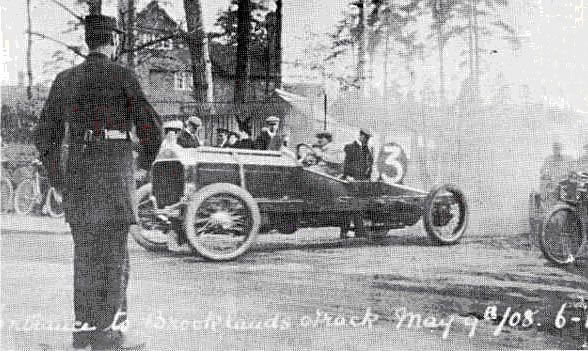
Brooklands 1908
Submitted by
Rick Feibusch, 2012
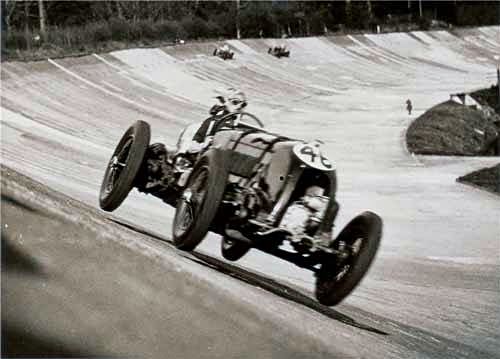
Brooklands
Submitted by
Rick Feibusch, 2012
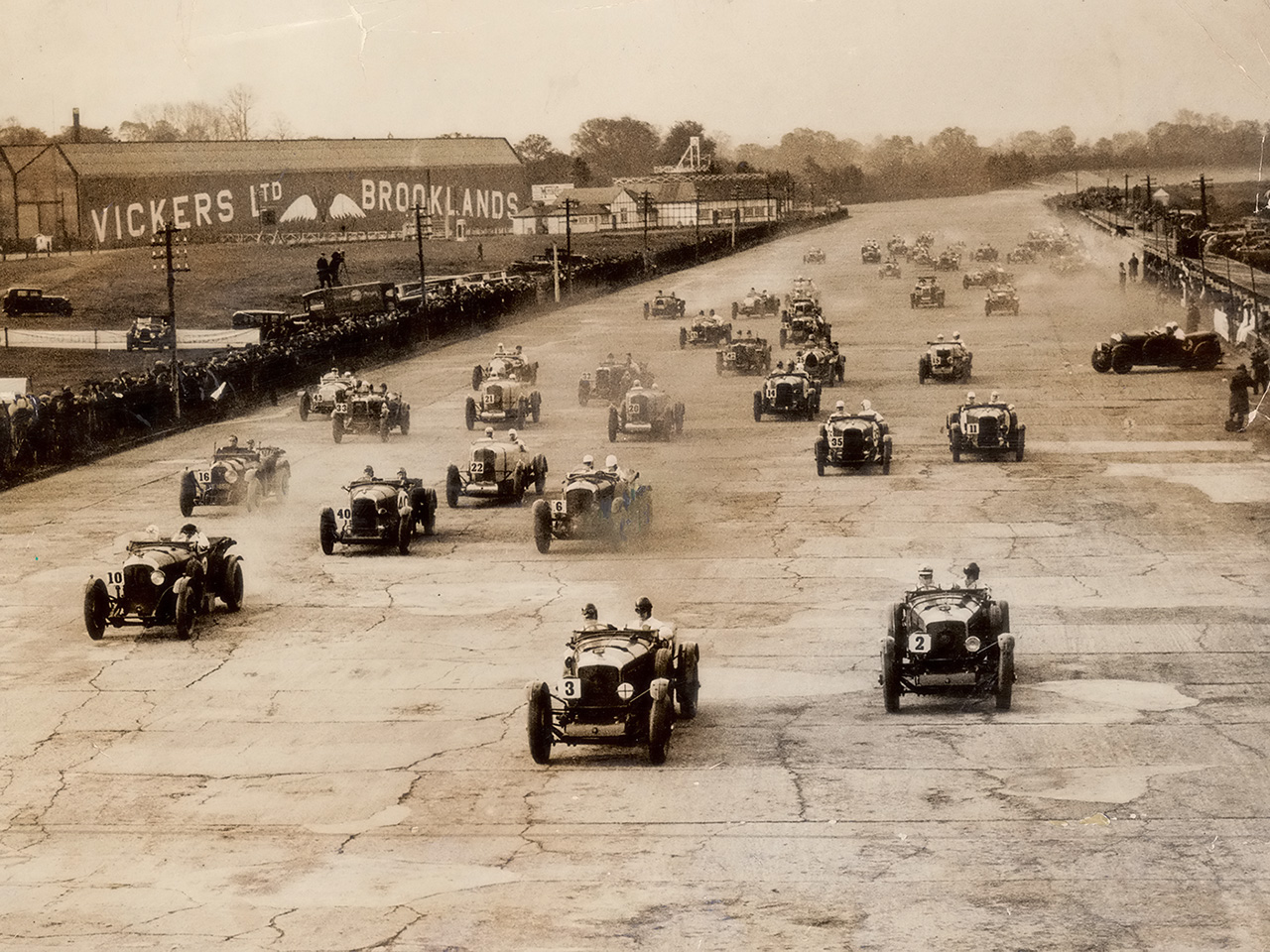
Brooklands 1932
Submitted by
Rick Feibusch, 2012
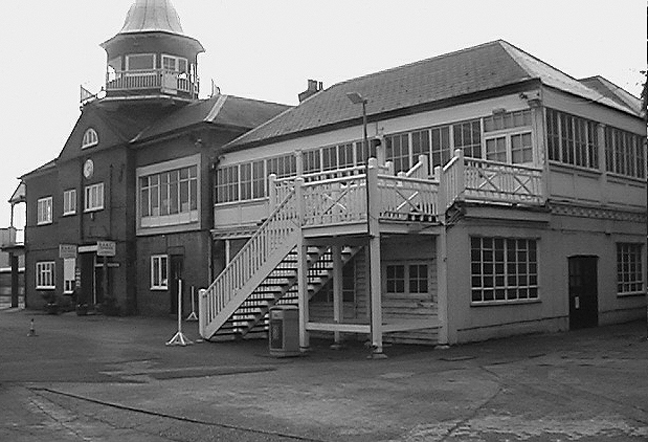
Brooklands Racetrack Clubhouse
Submitted by
Rick Feibusch, 2012
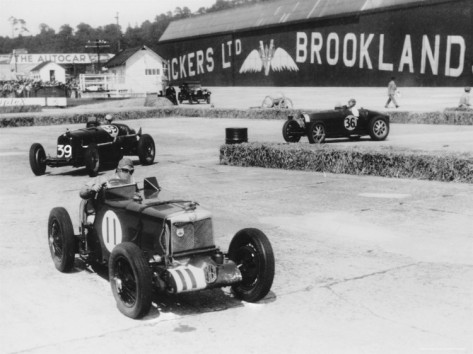
Brooklands 1935, MG, Alfa Romeo, Bugatti
Submitted by
Rick Feibusch, 2012
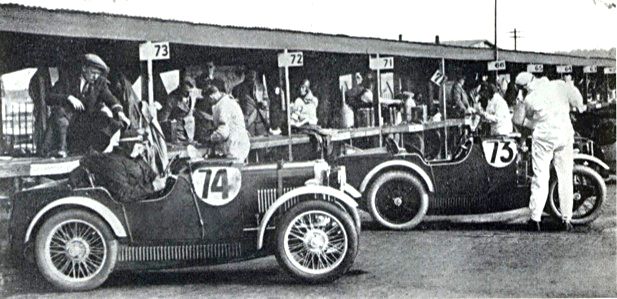
Brooklands MG 1931
Submitted by
Rick Feibusch, 2012
BACK TO TOP
|
|

















